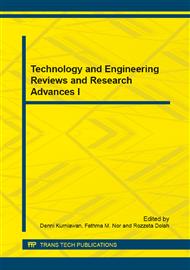p.122
p.128
p.141
p.145
p.149
p.154
p.159
p.163
p.168
Investigation the Behavior of a Four-Storey Steel Frame Using Viscous Damper
Abstract:
Vibration is a serious concern for tall structures during a natural disaster such as earthquake, wind storms, sea waves and hurricanes. The risk of occurrence of structural damage can be decreased by using a controlled vibration system to increase the damping characteristics of a structure. Damping is defined as the ability of the structure to dissipate a portion of the energy released during a dynamic loading event. The aims of this study are (1) to investigate a 4-storey 2D steel frame retrofit with viscous damper to reduce its vibration and (2) to demonstrate the performance of such a damper when fitted to a structure by analysis and tests the model. Therefore, a series of shaking table tests of the 4-storey 2D steel frame with and without viscous damper (VD) was carried out to evaluate the performance of the structure. The results of the experimental tests illustrate that viscous dampers decrease the structural responses of slender frame without changing their behavior on the shaking table. In other words, the displacement of the structure is reduced, however, there is no any transition of flexible to stiff structure related to its dynamic responses.
Info:
Periodical:
Pages:
149-153
Citation:
Online since:
February 2015
Authors:
Keywords:
Price:
Сopyright:
© 2015 Trans Tech Publications Ltd. All Rights Reserved
Share:
Citation:


